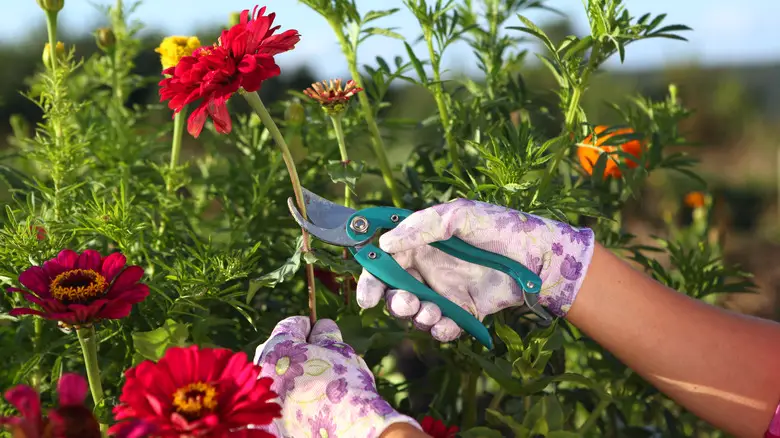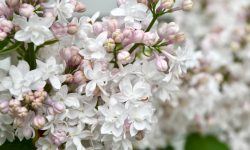Zinnias fill summer gardens with bright, cheerful colors that last from the first warm days to the first frost. These flowers grow fast, thrive in full sun, and reward even beginner gardeners with endless blooms. But to keep them full and colorful, pruning is essential. This simple habit makes a huge difference in how your zinnias grow and perform through the season.
Pruning helps zinnias grow bushier, produce more flowers, and stay healthy in hot weather. When you trim the right way and at the right time, the plants respond with strong new branches and a steady wave of blooms. It keeps the garden tidy, prevents legginess, and encourages more vibrant growth. With just a few careful cuts, you can turn an ordinary zinnia patch into a dense, colorful display that keeps shining all summer long.
Understanding Zinnia Growth Patterns Before Pruning

To prune zinnias effectively, you first need to understand how they grow. Zinnias begin as single-stem plants that produce one main stalk topped with a bud. Without pruning, that stalk quickly grows tall and produces one large bloom. After flowering, it usually stops growing upward, and only a few weak side branches appear. These side branches make the plant look thin and uneven, reducing the number of blooms over time. Learning how zinnias naturally develop helps you know where and when to cut to encourage fuller growth.
When a zinnia’s main stem is cut back early, it triggers new growth from the leaf nodes below the cut. Each node has the potential to produce two or more side stems, which then form additional buds. This branching process turns a single-stem plant into a compact, bushy one filled with flowers. The earlier you start pruning, the more branches the plant can produce before midsummer. Understanding this growth pattern allows you to control the shape and density of your zinnias with precision.
Different zinnia varieties also have unique growth habits that affect how you prune them. Tall cutting types like Benary’s Giant or State Fair benefit from early, deep pinching to promote strong branching. Compact varieties such as Profusion or Zahara naturally branch more but still respond well to light pruning for shape and flower production. Environmental conditions play a major role as well. Warm soil, at least six hours of sun, and well-drained ground encourage vigorous growth that responds beautifully to pruning. In contrast, crowded or shaded conditions create leggy, weak plants. By understanding these patterns and differences, you can confidently prune zinnias at the perfect points to achieve full, symmetrical, and endlessly blooming plants.
When to Start Pruning Zinnias for Maximum Blooms
Timing is one of the most important parts of pruning zinnias. Start pruning once your zinnia plants reach about eight to twelve inches tall and have at least four sets of true leaves. This early stage is ideal because the plant is still young, flexible, and full of growing energy. Cutting too early can weaken the stem before it establishes roots, while waiting too long allows it to grow tall and spindly. At this perfect height, pruning encourages the main stem to split into several strong branches that will soon support clusters of bright, long-lasting flowers.
Zinnias respond best to pruning in warm, stable weather when growth is active. Make the first cut about a quarter inch above a leaf node in the upper third of the stem. This simple snip halts upward growth and redirects energy toward new side shoots. Within a week or two, the plant will begin forming several lateral branches that will each produce buds. This process not only increases the number of flowers but also strengthens the overall structure, preventing bending or breaking during strong winds. Early pruning ensures the plant develops a balanced shape that supports constant blooming throughout the summer.
For the healthiest results, prune in the morning when the air is cool and the plant is hydrated. Avoid pruning during midday heat or after heavy rain, as this can increase stress and the risk of disease entering fresh cuts. After the first trimming, inspect your plants weekly and continue light pruning to remove faded blooms and weak stems. Consistent attention during the early growing phase leads to zinnias that remain vigorous, bushy, and colorful from the first bloom until the first frost, creating a season-long garden display.
How to Pinch Zinnias for Bushier Growth
Pinching is the simplest and most effective pruning method for zinnias. It involves removing the growing tip of the main stem to stimulate new branches. Begin pinching when the plant has developed at least four sets of leaves but before buds appear. Use clean fingers or sharp scissors to snip the top of the stem just above a leaf node. This cut stops vertical growth and encourages two or more new stems to form from the nodes below the cut. Within ten to fourteen days, the plant will start to branch out, creating a rounder, fuller shape. This early pinching step is crucial for promoting bushier growth and a longer bloom season.
Zinnias respond quickly to pinching because it redirects their energy toward lateral development. Each new branch eventually forms its own flower head, multiplying your total bloom count. Plants that are pinched once early in the season tend to stay shorter and more compact, which helps them resist wind damage. For larger zinnia varieties, a second light pinch on the new side stems can encourage even more branching. However, avoid over-pinching, as removing too many growing tips can slow down flowering. The goal is to create balance—enough branching for fullness, but not so much that blooms are delayed.
After pinching, give your zinnias a few days of gentle care. Water them deeply to help recovery, and ensure they receive full sunlight. Adding compost or a mild fertilizer supports strong regrowth. As the plants continue to develop, you’ll see dense foliage and numerous buds forming across each stem. This controlled, early pruning technique transforms simple zinnia seedlings into robust, flowering bushes that keep producing vivid blossoms throughout the summer and well into fall.
Deadheading Zinnias to Encourage Continuous Blooming
Deadheading is one of the most powerful techniques to keep zinnias blooming continuously. This process involves removing spent or faded flowers before they go to seed. Once a bloom starts to fade, the plant begins redirecting energy toward seed production instead of creating new flowers. By cutting off old blossoms regularly, you encourage the plant to produce more buds and extend its flowering cycle. Deadheading also keeps the plant neat, prevents disease, and improves airflow around the stems. The result is a garden that stays colorful and full of fresh blooms for months rather than just a few weeks.
To deadhead zinnias effectively, use clean, sharp scissors or garden snips. Cut the flower stem back to the next set of healthy leaves or a new bud forming on the side. This clean cut stimulates new growth from the leaf nodes and keeps the plant compact. For tall zinnia varieties, cutting slightly deeper into the stem helps maintain shape and prevents flopping. In smaller types, light trimming near the top is usually enough. Regular deadheading—every few days during peak bloom—ensures that the plant never stops producing flowers. Even one missed week can reduce blooming since zinnias quickly shift focus to seed formation.
Deadheading also improves overall plant health. Removing old flowers reduces moisture buildup that can attract pests or fungal diseases. It’s best to perform this task in the morning when plants are dry and the air is cool. Consistent maintenance through deadheading creates a cycle of renewal that lasts until the first frost. As new blossoms open, continue trimming old ones to maintain rhythm. This simple but essential habit guarantees your zinnias remain full of vibrant, long-lasting blooms that brighten every corner of your summer garden.
Shaping and Maintaining Zinnias Through Mid-Season Pruning
As zinnias mature, they often grow tall and start losing their compact shape, especially during mid-summer. Mid-season pruning helps restore balance and encourages a fresh flush of blooms. By cutting back older, leggy stems, you stimulate new branching from the base and sides of the plant. The best time to prune mid-season is after the first major wave of flowering. Use clean shears to remove about one-third of the plant’s height, focusing on the oldest and weakest stems. Within two weeks, new shoots will emerge, and the plant will begin another strong flowering cycle that lasts into fall.
This type of pruning is particularly useful for tall zinnia varieties that can become top-heavy and prone to leaning. Regular trimming keeps them sturdy and well-shaped, preventing them from falling over in wind or rain. Removing excess growth also improves air circulation, reducing the risk of mildew and fungal problems that often appear in humid summer weather. Mid-season pruning doesn’t just tidy up the plant—it rejuvenates it. By promoting fresh growth, you ensure a steady supply of strong stems for cutting and new flowers that bloom brighter and last longer.
After pruning, give your zinnias some extra care to help them recover. Water deeply, feed with a balanced fertilizer, and ensure they get full sunlight to support regrowth. Avoid heavy watering on freshly cut stems to prevent rot. Within a short time, your zinnias will regain their full shape, producing more blooms than before. This mid-season refresh keeps the plants productive, vibrant, and full of life, extending their flowering potential well beyond the height of summer.
Tools and Techniques for Safe and Effective Pruning
Pruning zinnias may seem simple, but using the right tools and careful techniques determines how well your plants recover and continue to bloom. Always start with sharp, clean pruning shears or garden scissors. Dull blades crush stems instead of cutting cleanly, leaving ragged wounds that heal slowly and invite disease. Before pruning, disinfect your tools with rubbing alcohol or a mild bleach solution. Doing so eliminates harmful bacteria and fungal spores that can spread between plants. Clean tools are essential for keeping your zinnias healthy through repeated trimming during the growing season.
When making cuts, always trim just above a leaf node or side branch. This technique encourages new shoots to grow from the node, creating a fuller, bushier plant. For pinching soft stems, clean fingers work well, but they must be free of dirt or sap from other plants to avoid contamination. Cut at a slight downward angle rather than straight across; this helps water slide off the cut surface, reducing the chance of rot. Work carefully and trim in small sections, stepping back occasionally to check the plant’s shape. Avoid removing more than one-third of the growth at a time, as heavy pruning can shock the plant and slow regrowth.
Time and weather conditions also affect pruning success. Perform pruning in the morning when the air is cool and dry. Avoid trimming during the heat of midday or after rainfall when leaves are wet. Once finished, water the base of the plant gently and apply a light layer of compost or organic fertilizer to aid recovery. Following these small yet vital steps ensures clean cuts, prevents disease, and helps your zinnias stay strong, producing a steady flow of fresh, vibrant blooms all summer long.
Common Mistakes to Avoid When Pruning Zinnias
Pruning Too Early or Too Late
Timing makes all the difference between healthy, bushy zinnias and stunted ones. Many gardeners prune too early, snipping before the plants develop a solid root system. When zinnias are still small, cutting their main stem shocks the plant and delays growth. Wait until each plant reaches eight to twelve inches tall and has at least four sets of true leaves. At that point, the roots are strong enough to support recovery, and the stems are mature enough to handle pruning without stress. Early pruning might seem helpful, but it weakens the structure and slows overall development, especially in cooler weather.
On the other hand, pruning too late—after buds have already formed—can drastically reduce flower production. Once buds appear, the plant focuses its energy on blooming. Cutting back stems at this stage forces it to redirect energy toward healing rather than producing flowers. If late pruning becomes necessary, only remove faded flowers or weak stems. Gentle, selective trimming preserves most of the plant’s energy for blooming. When you prune at the right time, zinnias respond with balanced growth, stronger stems, and more vibrant flowers that last through the entire summer season.
Cutting Too Much at Once
Zinnias are tough, but removing too much growth at one time can set them back severely. Over-pruning weakens the plant by reducing the number of leaves that produce energy through photosynthesis. A common rule is to never remove more than one-third of the total growth during a single session. When too many leaves or stems are cut, the plant struggles to recover and may stop flowering for several weeks. Gradual, consistent pruning gives zinnias time to regrow and maintain energy balance. The best results come from shaping them slowly over multiple sessions throughout the season.
After each pruning session, water deeply to help the roots recover and absorb nutrients. Applying a light feeding of compost or balanced fertilizer boosts regrowth and ensures steady bloom production. Regular observation helps you identify which stems need trimming next without shocking the plant. Zinnias that are pruned thoughtfully stay compact and bloom continuously, while over-pruned plants often appear weak and sparse. Controlled, patient pruning is key to lush, thriving zinnias that perform beautifully all season long.
Ignoring Cleanliness and Tool Care
Neglecting tool hygiene is one of the most common mistakes when pruning zinnias. Dirty or dull shears spread bacteria and fungi that can infect open wounds. Always clean your pruning tools before and after each use with rubbing alcohol or a mild bleach solution. This simple routine prevents cross-contamination between plants. Sharp tools are equally important—they make clean cuts that heal quickly and minimize stress. Dull blades crush the stems, leaving ragged edges that take longer to close and attract pests or disease.
Cleanliness extends beyond tools. Never prune zinnias when the foliage is wet or the garden is damp, as moisture spreads fungal spores easily. Wait for a dry, sunny day or prune in the early morning when plants are dry and strong. After trimming, remove all plant debris from the soil surface to prevent disease buildup. Proper sanitation and maintenance create a healthier growing environment where zinnias can thrive. By keeping your tools sharp, clean, and dry, you not only protect your plants but also promote faster healing and more vigorous blooms throughout the summer.
Reviving Overgrown or Neglected Zinnias
Zinnias can become tall, scraggly, or uneven when neglected or left unpruned for too long. The good news is that even overgrown zinnias can bounce back with a few careful steps. Start by examining the plant’s overall shape and identifying old or weak stems that have stopped blooming. Use clean, sharp shears to cut these stems back by one-third of their height, just above a leaf node. This process stimulates the dormant buds below the cut to produce new side branches. Within a couple of weeks, fresh green shoots begin to appear, signaling the plant’s recovery. Reviving zinnias this way encourages compact growth and helps them regain their full, rounded shape.
After pruning, proper care is essential for strong regrowth. Water the plants deeply to refresh the roots, and apply a balanced, slow-release fertilizer to boost nutrient levels. Zinnias respond quickly to renewed feeding and moisture. Make sure the plants receive full sun for at least six hours daily to promote healthy, sturdy stems. Removing faded blooms throughout the recovery period also prevents energy loss and keeps the plant focused on producing new flowers. In about three to four weeks, even neglected zinnias can return to full bloom with stronger branches and more vibrant colors. Consistent care after pruning is the key to a full revival.
If the zinnias are severely leggy or damaged, you may need to cut them back harder—sometimes to half their height. This may seem drastic, but healthy zinnias recover quickly in warm, sunny conditions. New shoots will emerge from the lower leaf nodes, producing dense foliage and abundant blossoms by late summer. Avoid fertilizing too heavily after a major cut, as excess nitrogen promotes leaf growth at the expense of flowers. With patience and balanced care, you can restore overgrown zinnias into lush, blooming plants that brighten your garden for weeks to come.
Seasonal Pruning Tips for Continuous Flowers
Spring: Establishing Strong Growth
Spring is the most important time to shape your zinnias for long-term success. When seedlings reach eight to twelve inches tall, prune or pinch just above a set of healthy leaves to encourage side shoots. This early trimming prevents the plant from growing tall and spindly. Each cut stimulates two or more new stems, laying the foundation for a dense, bushy structure. Healthy spring pruning ensures stronger stems capable of supporting the heavy blooms that will appear later in the season. Avoid pruning too early, as young seedlings need time to establish roots before handling stress.
After pruning, water deeply and add compost or a diluted liquid fertilizer to promote recovery. Keeping the soil consistently moist but not soggy helps the roots grow deep and strong. Place your zinnias in full sun to encourage robust branching and prevent stretching toward light sources. This early effort pays off by late spring when the plants begin forming buds across multiple stems. By shaping your zinnias early, you ensure the rest of the season is filled with balanced growth and continuous, colorful flowers.
Summer: Maintaining Shape and Prolonging Blooms
Summer brings the peak bloom period for zinnias, and consistent pruning keeps them at their best. The main task during this season is deadheading—cutting off spent flowers before they set seed. This simple act redirects energy from seed production to forming new buds, resulting in nonstop color. Trim old stems just above a healthy leaf node, and the plant will respond with fresh branches. If your zinnias begin to stretch or lean, cut them back by one-third to restore balance and shape. This midseason refresh encourages new flowering stems and strengthens the plant overall.
After pruning, feed your zinnias every four to six weeks with a balanced fertilizer to sustain vigorous blooming. Keep an eye out for signs of mildew in hot, humid conditions; pruning for airflow helps reduce this risk. Consistent deadheading, light shaping, and careful watering ensure zinnias bloom in cycles from early summer to late August. This steady care keeps your plants healthy, compact, and continuously bursting with bright color.
Fall: Extending the Final Flush
As temperatures begin to drop, fall pruning helps zinnias produce one last burst of blooms before frost. Cut back faded flowers and remove weak or damaged stems to direct energy toward new buds. Avoid heavy pruning during this time, as recovery slows in cooler weather. Instead, focus on tidying the plants and removing any diseased leaves to maintain air circulation. Light trimming every week keeps your zinnias producing vibrant flowers until cold nights finally arrive.
Adding a mild, phosphorus-rich fertilizer supports this final bloom cycle by enhancing color and flower size. Water your zinnias early in the morning to let foliage dry before evening, reducing the risk of mildew as humidity rises. As frost nears, you can harvest mature blooms for indoor arrangements or let a few flowers go to seed for collection. Gentle fall care allows your zinnias to shine one last time and ensures a graceful, colorful finish to the growing season.
Winter: Preparing for Next Season
Winter marks the end of the zinnia life cycle, but it also sets the stage for next year’s success. Once frost kills the plants, remove them completely from the soil to prevent pests and diseases from overwintering. Cut the stems to ground level and compost the healthy debris. Avoid leaving decaying material in the garden, as it can harbor fungal spores that affect future growth. After cleanup, enrich the soil with compost, aged manure, or leaf mold to restore fertility for next season’s planting.
Winter is also the perfect time to collect and store zinnia seeds. Choose the healthiest, most colorful blooms and allow them to dry fully before harvesting. Separate the seeds, label them by variety, and store them in a cool, dark place. This ensures strong, reliable germination next spring. By cleaning, amending, and resting your soil, you prepare an ideal environment for zinnias to thrive again. Proper winter maintenance guarantees a disease-free garden and a vibrant, fresh start when planting time returns.
FAQs About Pruning Zinnias
When should I prune zinnias for the first time?
Start pruning zinnias when they reach eight to twelve inches tall and have at least four sets of true leaves. At this stage, the stems are strong enough to handle trimming and respond with bushier growth and more flower buds.
How often should I deadhead zinnias?
Deadhead zinnias every few days during peak blooming season. Regularly removing faded flowers prevents seed formation, keeping plants focused on producing new blooms. Consistent deadheading encourages continuous color and stronger branching throughout the summer.
Can I prune zinnias that have already started blooming?
Yes, you can prune blooming zinnias, but only lightly. Trim faded or weak stems without removing too many buds at once. Light pruning promotes new blooms while preserving ongoing flower production during mid and late summer.
Should I use scissors or pinch zinnias by hand?
Both methods work well. Use clean scissors or pruning shears for thicker stems, and pinch soft growth with clean fingers for smaller plants. Always make cuts above a leaf node to encourage side branching and healthy new shoots.
Will pruning make zinnias bloom longer?
Absolutely. Pruning and deadheading stimulate new growth and keep the plant from going to seed. This steady cycle of regrowth and flowering extends the blooming period, allowing zinnias to stay vibrant and full of blossoms until the first frost.
Conclusion
Pruning zinnias is the secret to turning ordinary plants into spectacular, bushy bloomers that last all season. With timely pinching, regular deadheading, and careful mid-season shaping, you encourage stronger stems and a nonstop display of flowers. Each trim rejuvenates the plant, sparking fresh growth and brighter color. Zinnias thrive when given consistent attention—warm sunlight, healthy soil, and clean pruning tools. Whether you grow them in beds, borders, or pots, mastering pruning ensures your garden stays radiant from spring until frost. With just a few mindful cuts, your zinnias will reward you with unmatched beauty and endless summer charm.






